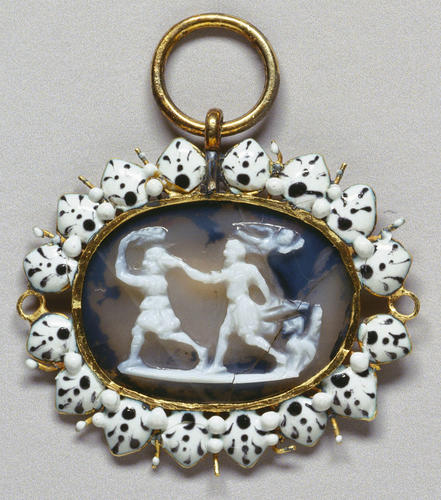-
1 of 253523 objects
Apollo and Daphne Cameo late 16th c. Mount: c. 1640 with 18th c. additions
Onyx: white on translucent pale grey; black shellac backing (missing on some pieces); open gold petal-like mounts with white enamel ‘petals’ with black dots, white enamel reverse, suspension loops, rings and smaller lateral loops to left and right | 1.9 x 2.4 cm (with fittings) | RCIN 65746

Jean Vangrol
Apollo and Daphne Cameo late 16th c. Mount: c. 1640 with 18th c. additions
-
Cameo depicting Apollo and Daphne: part of a set of eight onyx cameos of mythological and agricultural scenes mounted on gold and enamel petal-like mounts.
Small gems showing a variety of mythological and classical genre scenes were typically cut to be mounted into hardstone vases or gold and enamelled cups and bowls. They were produced in large numbers in the Milanese hardstone workshops of the sixteenth century. Their French seventeenth-century enamel mounts include lateral loops, however, which indicate that these seem to have been intended to be worn, either strung on a necklace or as other dress ornaments. Certainly in 1763, when Walpole made his additions to the Vertue inventory of the cabinet rooms, he noted ‘many cameos, small set in enamel as if designed for buttons’.
Text adapted from The First Georgians: Art and Monarchy 1714 - 1760, London, 2014Provenance
Part of a set probably identifiable with the ‘many cameos, small set in enamel as if designed for buttons’, listed by Horace Walpole in his 1763 addenda of ‘Other pictures & Curiosities’ of the late Queen Caroline, consort of George II, at Kensington Palace.
-
Creator(s)
(enameller)Acquirer(s)
-
Medium and techniques
Onyx: white on translucent pale grey; black shellac backing (missing on some pieces); open gold petal-like mounts with white enamel ‘petals’ with black dots, white enamel reverse, suspension loops, rings and smaller lateral loops to left and right
Measurements
1.9 x 2.4 cm (with fittings)
1.3 x 1.7 cm (cameo)